But there is something that the local library, wikipedia and my teenager memories cannot fulfill: they cannot give me my own answer.
And that's why I made this experiment.
As with every experiment, I need an...
Idea to test: Plants are green because of sunlight, so if they get no light they will not be green, as they cannot photosynthesise. That's what we expect. And what about tomatoes? Somebody told me they are red colour because of carotenoids, the organic pigments produced by plants along with chlorophyll. Carotenoids, especially lycopene, absorb blue light and reflect red light.
So, the idea is: if a leaf cannot photosynthesise, it will be any colour but green, and if the tomato cannot photosynthesise, it will be any colour but red or green. Maybe yellow, maybe brown, but not the usual colour. Here is the specific idea I want to test:
The material: Aluminium kitchen foil, bought in the local supermarket, and a tomato plant.
The set-up and measures: Well, I have not a "green-meter", so to compare the differences I just took photos from time to time. The experiment lasted 39 days.
The experiment starts!
Unfortunately I didn't take a photo of the tomato leaf before wrapping it up, so you will have to believe me when I say that it was pretty the same than the other non-wrapped leaves you can see in this photo:

For the tomato, I chose one from a branch with four tomatoes, so I could compare better the differences between the selected tomato and its "brothers". Here is how this branch looked like in a previous photo I took on 28th July:

Here is a closer view:

And here is the same branch with the wrapped tomato on 3rd August:

This is how the leaf looked like some days later:

Its end was a bit damp (which probably was due to the fact that it had been in a closed space), but it looked as green as it was the first day.
Unfortunately I didn't take a photo of the unwrapped tomato, but there were not many changes as well: the four tomatoes were very green, and probably not very tasty.
The leaf looked as green as the other leaves, but touching it I could feel it was weaker, softer than the rest.

The tomato was a bit smaller than the other three (which could be casual), but no sensible changes were observed:

Here is how the leaf looked like almost four weeks later (obviously, the only moment when I removed the aluminium foil was while taking the photos):

there are no major changes in colour, but the wrapping is centainly affecting the leaf's health. Now the end of the leaf looks like burned, and perhaps a bit more yellowish.
However, the tomato looks perfect (it's the left one in this photo):

Note that one of the four brothers (the one at the back which can barely be seen) is getting redder and redder!
Last day. The "leaf disease" is in an advanced state and the "patient" will probably not last very long:

The colour is still green, maybe a bit more yellowish near the edge at the end.
Two of the four tomatoes were eaten in a great salad, but we left one brother to compare with the selected tomato:

They are both fairly red and start looking very tasty, but wait... what's at the bottom of our friend? Maybe we can see better from below:

oh, it looked so healthy, but actually was starting to rot away! More or less the same that happened to the leaf. But the colour is exactly the same as its brother's colour.
Conclusion: During these 39 days I have not seen too many changes in colour, which has been surprising. However, the aluminium foil has obviously affected both the leaf and the tomato, as they started to rot away. I can think of three reasons for this:
- lack of light weakened them, making them more vulnerable,
- closed space kept them wet, which contributed to the rotting process,
- the tight contact with aluminium, which is not quite natural for a tomato plant, could have triggered the rotting process.
Anyhow, colour didn't change discontinuously at the edge of the aluminium foil, as I thought. Why? Are chloroplasts distributed evenly through all the plant, regardless of the place where they photosynthesise? Maybe it can be interesting making another experiment covering the whole plant, to check how different is its colour from the colour of another plant with good sunlight. But for the moment... let's eat a salad!
















